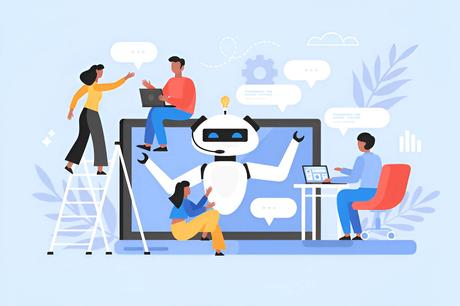I explore hundreds of pages each day while browsing the internet. Although I frequently recall interesting information from my browsing, the websites are notmemorable. Nevertheless, there are exceptions. I will recall websites with a smooth user experience and compelling design.
It is becoming increasingly crucial to remain informed about web development trends to guarantee a website that is user-friendly, functionally competitive, and secure. Your website’s efficacy and user experience can be significantly impacted if you neglect to stay informed about recent trends. Subsequently, your traffic volume will decrease.
“In this post, I take a more in-depth look at the top web development trends to watch for in 2024.
Web Development Trends in 2024
- AI ChatBots
- Progressive Web Apps
- Artificial Intelligence
- Single Page Application
- Optimized Voice Search
- Accelerated Mobile Pages
- WordPress Development
- Responsive Site Design
- Motion UI
- Serverless Architecture
- Dark Mode Standardization
- Blockchain Technology
- Improve Cybersecurity
Many web development trends are already in existence, which may come as a revelation to you. It is more important than ever to adapt these best practices, as they will become more prevalent in the future years. Let us examine the web development trends of 2024 that you should be aware of.
1. AI ChatBots
Artificial Intelligence (AI) chatbots are revolutionizing customer service and interaction. By simulating human conversation, AI chatbots provide instant responses, handle multiple queries simultaneously, and improve user satisfaction. With advancements in natural language processing (NLP) and machine learning, these chatbots are becoming more sophisticated, making them an essential tool for any website.

For example, AI-powered chatbots like IBM’s Watson and Google’s Dialogflow offer advanced conversational abilities, helping businesses provide 24/7 customer support and personalized user experiences. By integrating these chatbots into websites, businesses can enhance user engagement and streamline customer service operations.
Read More: 15 Best AI Chatbots for Customer Support in 2023
2. Progressive Web Apps
Progressive Web Apps (PWAs) combine the best of web and mobile apps. They offer a seamless user experience, fast load times, and the ability to work offline. Unlike traditional web apps, PWAs are reliable, engaging, and can be installed on any device. Businesses like Twitter and Starbucks have successfully adopted PWAs, resulting in improved performance and user engagement.
PWAs utilize modern web capabilities to deliver an app-like experience directly in the browser. Technologies such as service workers, web app manifests, and push notifications contribute to their functionality and reliability. PWAs are also cost-effective, as they eliminate the need to develop separate applications for different platforms.
3. Artificial Intelligence
AI is not just limited to chatbots. It’s being used to personalize user experiences, predict user behavior, and automate processes. AI-driven analytics provide insights into user interactions, allowing for more targeted marketing and content creation. As AI continues to evolve, its integration into web development will only deepen, offering smarter and more intuitive websites.

Companies like Netflix and Amazon use AI to personalize content recommendations based on user preferences and viewing history. AI algorithms analyze vast amounts of data to deliver tailored experiences, enhancing user satisfaction and engagement.
Related: A Deep Dive into Artificial Intelligence in Pakistan
4. Single Page Application
Single Page Applications (SPAs) load a single HTML page and dynamically update content as the user interacts with the app. This provides a faster and more seamless user experience compared to traditional multi-page applications. Popular frameworks like Angular, React, and Vue.js facilitate the development of SPAs, making them a preferred choice for modern web applications.
SPAs reduce server load and improve performance by loading content dynamically, which results in faster navigation and a smoother user experience. They are particularly well-suited for applications that require real-time updates and complex interactions.
5. Optimized Voice Search
With the rise of voice assistants like Siri, Alexa, and Google Assistant, optimizing websites for voice search is becoming increasingly important. Voice search optimization involves using natural language, focusing on long-tail keywords, and ensuring fast load times. Tools like Google’s Search Console can help monitor and improve a website’s performance for voice search.

Voice search optimization also involves structuring content in a way that directly answers user queries. This includes creating FAQ sections, using schema markup, and optimizing local search results. As voice search continues to grow, websites that adapt to this trend will gain a competitive edge.
6. Accelerated Mobile Pages
Accelerated Mobile Pages (AMP) are designed to load web pages quickly on mobile devices. AMP enhances the mobile browsing experience by reducing load times and improving performance. Implementing AMP involves using a streamlined version of HTML, known as AMP HTML, which ensures faster rendering and a better user experience for mobile users.
AMP is particularly beneficial for content-heavy websites, such as news sites and blogs. By prioritizing speed and performance, AMP helps retain users and reduces bounce rates. Companies like The Washington Post and BBC have successfully implemented AMP to improve their mobile presence.
7. WordPress Development
WordPress continues to dominate as the most popular content management system (CMS). In 2024, expect to see more innovations in WordPress development, including advanced plugins, themes, and integrations. WordPress’s flexibility makes it ideal for e-commerce, blogging, and business websites, offering endless customization options.
The latest updates in WordPress, such as the Gutenberg block editor and improved security features, enhance user experience and development capabilities. Popular plugins like WooCommerce and Yoast SEO further extend WordPress’s functionality, making it a versatile platform for various web development needs.
Related: The Top 10 WordPress Hosting Companies for 2023
8. Responsive Site Design
Responsive design ensures that websites function well on all devices, from desktops to smartphones. With the increasing use of mobile devices, having a responsive site is crucial. Techniques like flexible grids, responsive images, and media queries help achieve a responsive design, providing a consistent user experience across different screen sizes.
Responsive design also improves search engine rankings, as Google prioritizes mobile-friendly websites in its search results. Websites like The Guardian and Dropbox exemplify excellent responsive design, adapting seamlessly to different devices and screen sizes.
9. Motion UI
Motion UI involves the use of animations and transitions to enhance user experience. It adds a layer of interactivity, making websites more engaging and visually appealing. Motion UI can guide users, provide feedback, and create a more dynamic interface. Tools like CSS and JavaScript libraries enable the implementation of motion UI in web development.
For instance, websites like Stripe and Airbnb use subtle animations to improve navigation and highlight key elements. Motion UI not only captures users’ attention but also enhances usability by providing intuitive visual cues.
10. Serverless Architecture
Serverless architecture allows developers to build and run applications without managing servers. It offers scalability, cost-efficiency, and simplified backend processes. Services like AWS Lambda and Google Cloud Functions enable serverless computing, allowing developers to focus on writing code without worrying about infrastructure management.
Serverless architecture reduces operational overhead and ensures that applications can scale automatically to handle varying loads. It is particularly useful for applications with unpredictable traffic patterns and those that require rapid deployment and iteration.
11. Dark Mode Standardization
Dark mode is gaining popularity for its aesthetic appeal and reduced eye strain. Implementing dark mode involves creating a dark-themed version of a website that users can toggle on or off. Tools like CSS custom properties and prefers-color-scheme media queries facilitate the implementation of dark mode.
Dark mode enhances user experience by providing an alternative to the traditional light mode, particularly in low-light environments. Websites like YouTube and Twitter offer dark mode options, catering to user preferences and improving accessibility.
12. Blockchain Technology
Blockchain technology is making its way into web development, offering enhanced security and transparency. Blockchain’s decentralized nature ensures data integrity and reduces the risk of tampering. Applications of blockchain in web development include secure payment processing, digital identity verification, and decentralized applications (dApps).

Blockchain technology also enables the creation of smart contracts, which are self-executing contracts with the terms directly written into code. Platforms like Ethereum and Hyperledger facilitate the development of blockchain-based applications, opening new possibilities for secure and transparent web interactions.
13. Improve Cybersecurity
As cyber threats continue to evolve, improving website security is paramount. Implementing strong cybersecurity measures protects user data and ensures the integrity of online transactions. Best practices include using HTTPS, regularly updating software, implementing firewalls, and conducting security audits.
Tools like Cloudflare and Norton Security offer comprehensive cybersecurity solutions, including DDoS protection, SSL certificates, and malware detection. By prioritizing cybersecurity, businesses can build trust with their users and safeguard their online presence.
Conclusion
The web development landscape is constantly evolving, driven by technological advancements and changing user expectations. Staying updated with the latest trends is essential for creating innovative, user-friendly, and secure websites. The trends outlined in this article, from AI chatbots to blockchain technology, are set to shape the future of web development in 2024 and beyond. By embracing these trends, developers and businesses can stay ahead of the curve and deliver exceptional online experiences.

